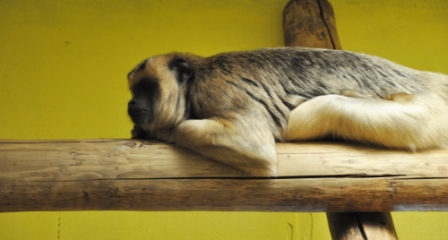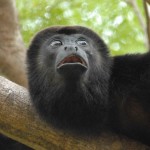Black Howler Monkey
Alouatta caraya
Habitats: Found in tropical forest where rains are nearly constant throughout the year, and tropical deciduous forest spotted with Savanna like openings where there is a marked wet, warm season and a dry, cool season.
Threats: These Howler monkeys need forests with diverse species of plant life for food; much of their habitat is disappearing due to destruction of these forest types. This species is also threatened by habitat loss due to agricultural development for farm and cattle ranching.
Social Behaviour: Most howler monkeys live in large social groups generally made up of 5-8 family members, though they have been observed in the wild in groups up to 19 individuals. The groups have roughly equal sex ratio but may tend to have more females than males. A. caraya are territorial but seem to only defend the immediate area where they are at the time, and territories often overlap.
Food: Black Howlers rarely come down from the trees as their food source is entirely in the canopy. They are folivorous – they eat mostly leaves but also fruits, buds and flowers and their molar teeth are particularly adapted for chewing the leaves, through shearing.
Range: Found through the forests of Argentina, Bolivia, Brazil and Paraguay.
Information: Howler monkeys have special structures in their throats (enlarged hyoid and larynx) that help make their calls so loud. These structures are hollow and egg-shaped, and they act like echo chambers. They are even larger in males, so their voices are louder and deeper.
Conservation: our charity The Wildlife Protection Foundation funds “Ecosantafe” Red Howler Monkey Conservation project in Colombia. Red Howler Monkeys are a close relative of the Black Howler Monkey. To find out more you can go to http://www.wildlifeprotection.info





